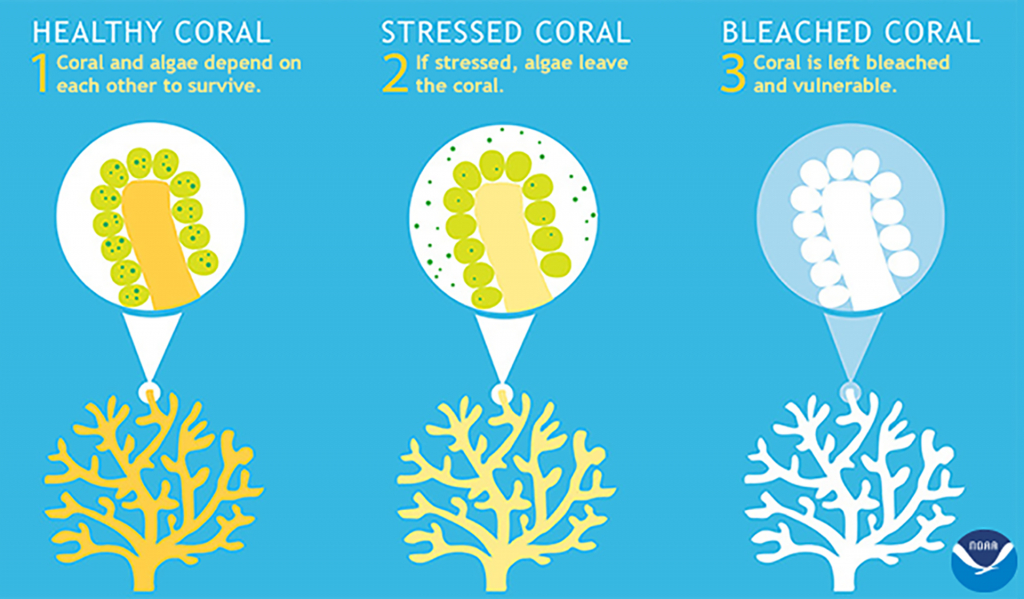Coral Bleaching

- 19 Apr 2024
Why is it in the News?
The fourth global mass coral bleaching event has been triggered by extraordinary ocean temperatures, the US National Oceanic and Atmospheric Administration (NOAA) said recently.
What are Corals and Coral Reefs?
- Corals are essentially animals, which are sessile, meaning they permanently attach themselves to the ocean floor.
- They use their tiny tentacle-like hands to catch food from the water and sweep it into their mouth.
- Each individual coral animal is known as a polyp and it lives in groups of hundreds to thousands of genetically identical polyps that form a ‘colony’.
- Corals are largely classified as either hard coral or soft coral.
- It is the hard corals that are the architects of coral reefs — complex three-dimensional structures built up over thousands of years.
- Unlike soft corals, hard corals have stony skeletons made out of limestone that are produced by coral polyps.
- When polyps die, their skeletons are left behind and used as foundations for new polyps.
- Coral reefs, also referred to as “rainforests of the sea”, have existed on the Earth for nearly 450 million years.
- Australia’s Great Barrier Reef is the largest in the world, stretching across 2,028 kilometers.
What is the Significance of Corals?
- Coral reefs have a crucial role in marine ecosystems.
- Thousands of marine species can be found living on one reef.
- For instance, “the Great Barrier Reef contains over 400 coral species, 1,500 fish species, 4,000 mollusc species and six of the world’s seven sea turtle species”.
- Research has shown that there could be millions of undiscovered species of organisms living in and around reefs.
- These massive structures also provide economic goods and services worth about $375 billion each year.
- More than 500 million people across the world depend on coral reefs for food, income, and coastal protection from storms and floods.
- Coral reefs can absorb up to 97% of the energy from waves, storms, and floods, which prevents loss of life, property damage, and soil erosion.
- Therefore, the absence of coral reefs would not only result in severe ramifications for marine life but also for humans.
What is Coral Bleaching?
- Most corals contain algae called zooxanthellae ( plant-like organisms) in their tissues.
- Corals and zooxanthellae have a symbiotic relationship.
- While corals provide zooxanthellae a safe place to live, zooxanthellae provide oxygen and organic products of photosynthesis that help corals to grow and thrive.
- Zooxanthellae also give bright and unique colors to corals.
- Corals are very sensitive to light and temperature and even a small change in their living conditions can stress them.
- When stressed, they expel zooxanthellae and turn entirely white.
- This is called coral bleaching.
- Coral bleaching doesn’t immediately lead to the death of corals.
- They rather go under more stress and are subject to mortality.
- Coral bleaching reduces the reproductivity of corals and makes them more vulnerable to fatal diseases.
- If the bleaching is not too severe, corals have been known to recover.
- Global mass bleaching of coral reefs is when significant coral bleaching is confirmed in the Atlantic, Indian, and Pacific oceans.
- Such events are a relatively new phenomenon.
- The first one took place in 1998 in which 20% of the world’s reef areas suffered bleaching-level heat stress.
- The next two global bleaching events occurred in 2010 (35% of reefs affected) and between 2014 and 2017 (56% of reefs affected).
What can be the impact of the event?
- As the global mass bleaching event is still unfolding, its full impact will not be known for a while.
- With global temperatures soaring, such events are expected to become more frequent and longer.
- As a result, the world may lose the vast majority of its coral reefs at 1.5 degrees Celsius of warming, and virtually all at 2 degrees.
- Currently, the average global temperature of the Earth has increased by at least 1.1 degree Celsius since 1850.
- To curb global warming to no more than 1.5 degrees Celsius, countries need to bring GHG emissions to a net zero by 2050, according to the Paris Agreement.
The goal, however, is unlikely to be achieved as record levels of GHG emissions have continued to be emitted into the atmosphere.
